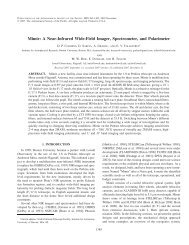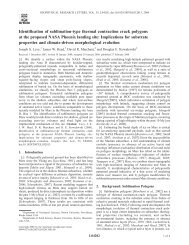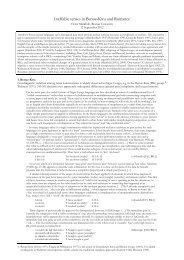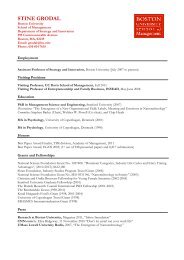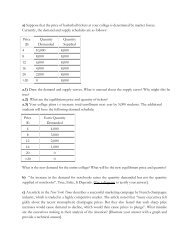Intertemporal Substitution and Recursive Smooth Ambiguity ...
Intertemporal Substitution and Recursive Smooth Ambiguity ...
Intertemporal Substitution and Recursive Smooth Ambiguity ...
Create successful ePaper yourself
Turn your PDF publications into a flip-book with our unique Google optimized e-Paper software.
2. Review of the Atemporal ModelsIn this section, we provide a brief review of the atemporal models of ambiguity proposed byKMM (2005) <strong>and</strong> Seo (2009). We will embed these models in a dynamic setting in Sections3-4. Both atemporal models when restricted to the space of r<strong>and</strong>om consumption deliver anidentical representation in (1). The two models differ in domain <strong>and</strong> axiomatic foundation.For both models, we take a complete, transitive, <strong>and</strong> continuous preference relation ≽ asgiven.Consider the KMM model first. KMM originally study Savage acts over S × [0, 1], wherethe auxiliary state space [0, 1] is used for describing objective lotteries. Here we translatetheir model in the Anscombe-Aumann domain. Let S be the set of states, which is assumedto be finite for simplicity. Let C be a compact metric space <strong>and</strong> ∆(C) be the set of lotteriesover C. 9An Anscombe-Aumann act is defined as a mapping g : S → ∆(C). Let G denotethe set of all such acts.In order to pin down second-order beliefs, KMM introduce anauxiliary preference ordering ≽ 2 over second-order acts. A second-order act is a mappingg : P → ∆(C), where P ⊂ ∆(S). Let G 2 denote the set of all second-order acts.The preference ordering ≽ over G <strong>and</strong> the preference ordering ≽ 2 over G 2 are representedby the following form:<strong>and</strong>∫U (g) =Pφ∫U 2 (g) =( ∑s∈SPπ (s) ū (g (s)))φ (ū (g (π))) dµ (π) , ∀g ∈G 2 ,dµ (π) , ∀g ∈ G, (7)where φ : u (∆(C)) → R is a continuous <strong>and</strong> strictly increasing function <strong>and</strong> ū : ∆(C) → Ris a mixture-linear function. 10The previous representation is characterized by the following axioms: 11 (i) The preference≽ satisfies the mixture-independence axiom over the set of constant acts ∆(C). (ii) Thepreference over second-order acts ≽ 2 is represented by subjective expected utility of Savage(1954). (iii) The two preference relations ≽ <strong>and</strong> ≽ 2 are consistent with each other in the sensethat g ≽ h if <strong>and</strong> only if g 2 ≽ 2 h 2 , where g 2 is the second-order acts associated with g defined9 We use the following notations <strong>and</strong> assumptions throughout the paper. Given a compact metric spaceY , let B(Y ) be the family of Borel subsets of Y , <strong>and</strong> ∆(Y ) be the set of Borel probability measures definedover B(Y ). Endow ∆(Y ) with the weak convergence topology. Then ∆(Y ) is a compact metric space.10 A function f is mixture linear on some set X if f (λx + (1 − λ) y) = λf (x)+(1 − λ) f (y) for any x, y ∈ X<strong>and</strong> any λ ∈ [0, 1] .11 The proof can be obtained from our proof of Theorem 1 in Appendix A.7



